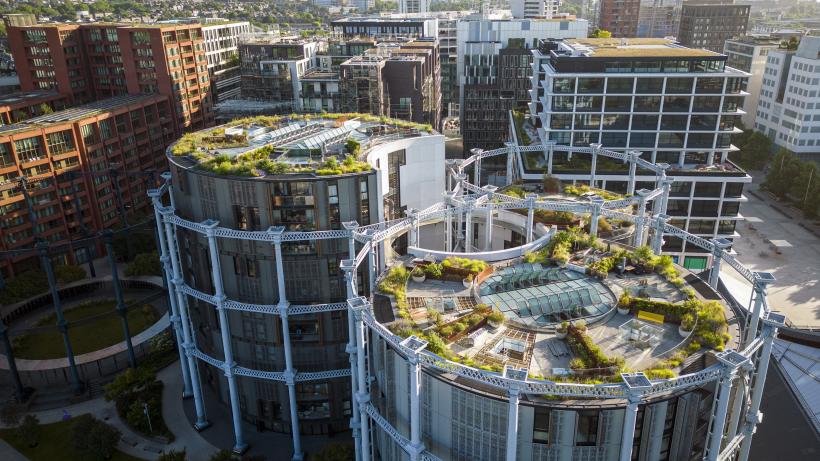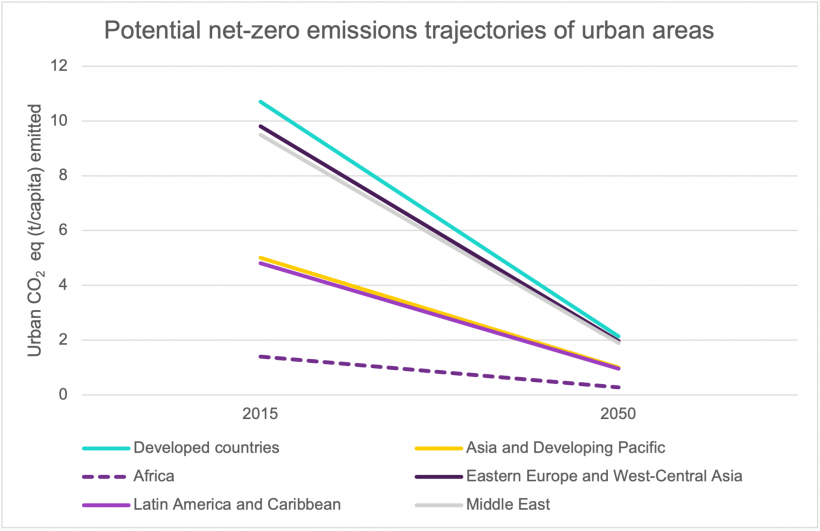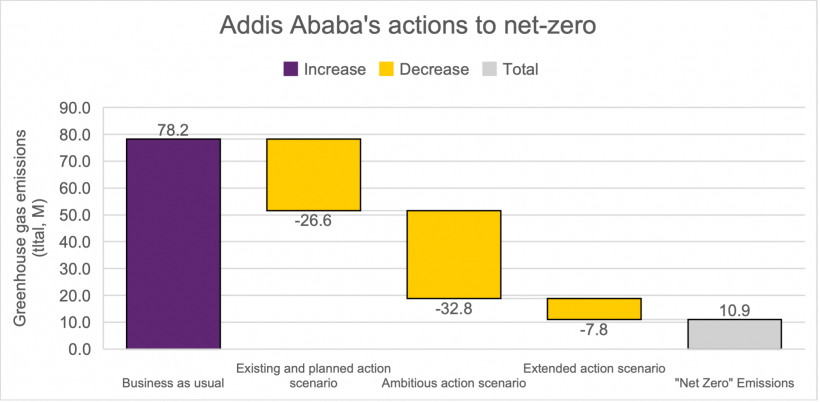
Quantifying sustainable urbanisation pathways in developing country cities
Climate change has highlighted tensions that exist between development and its externalities. We need a pathway that delivers the socioeconomic progress and poverty alleviation—essential for developing countries—while minimising negative impacts on current and future generations. Current global frameworks for emissions reductions—while useful in harmonising action, require tailoring for developing country cities. Otherwise, we risk substantial urban emission inequity.
Addressing climate change is of higher urgency for poorer countries than wealthier ones—the former are more threatened by, and vulnerable to climate deterioration. Yet no clear international framework for development while reducing emissions exists that adequately accounts for this vulnerability, while also acknowledging the limited historical contribution of these exposed countries to the climate crisis.
Many proposed low-carbon, resource-efficient development pathways, aiming to address the climate challenge are lacking . Some are poorly quantified—for example, when measuring green growth, the indicators are at times inconsistent and vague. Others have unclear definitions—for example, those delineating which citizen groups are targeted under inclusive growth. There are also those which are not geographically or economically appropriate—for example, the degrowth movement which focuses on ‘global north’. Most recently, “net-zero” arguably places unjust burdens on low-income, fast-urbanising cities. Multiple transitions pathways, that are tailored at the national (and local) level, and consistent with climate justice, are needed for global emissions reductions. [See IGC’s forthcoming Sustainability White Paper for more information on these definitions.]
Two of the most recent and prominent attempts to unite countries in the fight against climate change are “low-carbon” or “low-emission development”, and “net-zero development”. Developing country cities should focus primarily on context specific low-emission development while incorporating some principles from net-zero. This stands in contrast to developed country cities, who carry more of the global burden of emission reduction and should wholly target net-zero development.
Under net-zero emissions targets, cities commit to more than 80% emission reductions from current levels to their target date (often 2050). The other 20% to achieve ‘net-zero’ is targeted by regional carbon sequestration projects – or, nature-based solutions—projects which have nature-positive or environmental co-benefits. These can have mangrove planting, reforestation or afforestation at their core. The combination of emissions removal in addition to emissions reduction is the defining characteristic of net-zero. It is defined and quantifiable.
Yet, simply utilising net-zero, ignores past development pathways and might harm the socioeconomic potential of developing country cities. Typically, these lower income, less developed cities had lower emissions. Thus, reducing from these levels and achieving net-zero means different things to cities in different stages of development. Figure 1 below illustrates this. For example, to achieve net-zero in 2050, developed country cities will need a reduction from approximately 11 tonnes CO2-equivalent per person (tCO2-eq/pp) in 2015 to 2 tonnes in 2050. Contrastingly, less developed, Asian cities (including India and China) will need a reduction from their current 5 tonnes to 1 tonne. The paradox of pathways is most stark when realising African cities today are already emitting less per person than the developed country net-zero cities of 2050. Thus, while bringing useful principles, there is a need for more inclusive emissions reconciliation in the net-zero transition—aligning development pathways with current emissions.
Figure 1: Net-zero emissions trajectories and carbon sequestration needs of urban areas

Notes: Due to lack of intermittent data, assumed linearity of net-zero process. Data from IPCC, where trends in Luqman et al. (2021) were combined with the work of Moran et al. (2018) to estimate the regional urban CO2-eq share of global urban emissions, the urban share of national CO2-eq emissions, and the urban per capita CO2-eq emissions by region. The total values exclude aviation, shipping, and biogenic sources. Author combined this data with net zero trajectories as outlined in (Seto et al 2021).
This lack of global cohesion becomes evident in the net-zero uptake. There is keen interest but poor quantification. As of November 2022, governments covering 80% of global greenhouse gas (GHG) and 90% of global economy had communicated a net-zero target, but COP27 showed less than half of cities are measuring—or quantifying—progress. Geographically, there is regional variation in take up with Africa and South Asia showing less progress in discussion, planning, and reporting.
Notably, Addis Ababa is the only African city with a net-zero climate action plan.
The city’s intention is to reduce from the “business-as-usual’s” 78 million tonnes of GHG emissions by 2050, to 11 million tonnes. Figure 2 below shows its path to net-zero emissions. It exhibits how the city must act with breadth and depth, going beyond ‘existing and planned actions’, beyond ‘ambitious action’, to deliver on ‘extended action’ to reach net-zero. In achieving this aim, if Addis Ababa has the estimated population of 13 million by 2050, the net-zero city will then emit less than 1 tonne GHG per person. Comparatively, if 2050’s developed cities do achieve a net-zero path, as Figure 1 shows, they will still be emitting double this amount.
Even if Addis Ababa achieves net-zero by 2050, it will still experience substantial emission inequity compared to developed country cities. Economic development requires sharp increases in energy consumption, some of which will be available through renewables. Yet, the question remains whether Addis Ababa and the other cities of Ethiopia, where each citizen uses 170 times less kilowatt-hour (energy) per year than their counterparts in USA—and who also have incomes of 25 times less—will be restricting their development potential by targeting net-zero.
Figure 2: Addis Ababa's actions to net-zero

Note: Data from Addis Ababa Climate Action Plan. This ambitious and extended action by Addis Ababa still requires 10.9M tonnes of GHG emissions to be sequestered, indicated in the final bar.
Rather than net-zero, developing country cities should look to build low-emission strategies for development—allowing their emissions to grow slowly to align with levels similar to their developed country city peers. This is proposed for the following reasons:
- It takes a ‘development first’ approach—arguably better for developing countries as it integrates and addresses climate change with development objectives.
- It acknowledges that an equitable and just transition is necessary as developing country cities are developing from relatively low emission benchmarks. Therefore, notwithstanding issues of carbon lock-in, they should consider small emissions rises to match the levels of developed country ‘net-zero’ cities.
- “Emissions”, rather than “carbon” is utilised as a metric, recognising the danger of super pollutants such as methane which trap significantly more heat at a local level.
Low emission approaches can be improved by applying lessons from net-zero development pathways in the following ways.
- The approach can learn on quantification. Currently, targeted emissions in ‘low-carbon’ reductions vary from 20% to 100% of current levels—much broader in scope than net-zero.
- It can also learn on definition. Low-emission also suffers from no formal definition—leading to potential ambiguity.
- Finally, it can learn on inclusion of sequestration action and targets. This is the missing empirical aspect of emission removal—an important part of any sustainable urban development action. Efforts should be made to rectify these.
Sustainable urbanisation is an important policy goal for most developing country governments, but to be meaningful, it needs refinement, empirical grounding and proper quantification for measurement. Most importantly, it must consider climate justice and equity for wider buy in and hope for successful delivery. We must exercise caution with blanket global approaches to emissions when considering sustainable development. For developing country cities, low-emission development—that incorporates lessons from net zero—represents a useful framework for achieving these aims.
The forthcoming 7th Urbanisation and Poverty Reduction Conference will bring together academics and development practitioners to discuss questions relating to climate change and sustainable cities. You can watch the Opening Session and Keynote Address here. For more information on sustainable urbanisation, read our recent publications on Cities as places to innovate, trade, and work and Cities as places to live.

